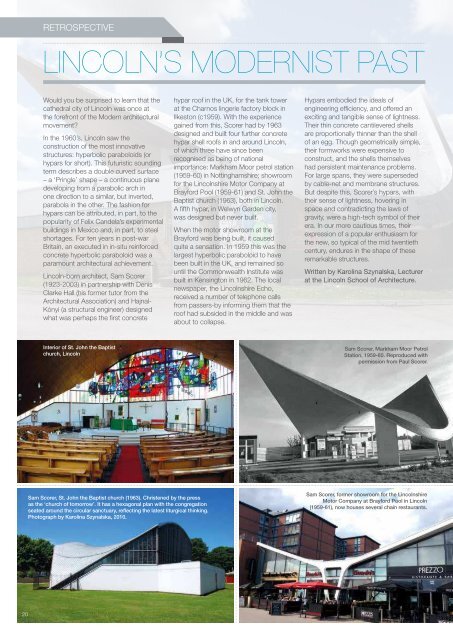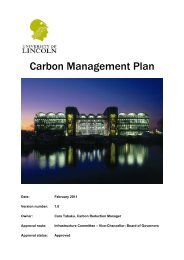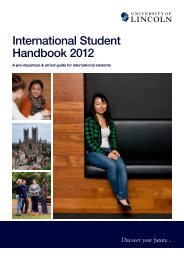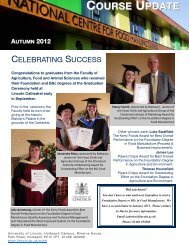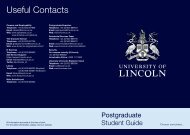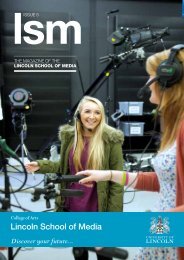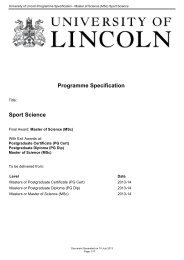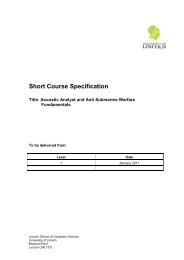LSA Magazine Issue 2 (PDF) - University of Lincoln
LSA Magazine Issue 2 (PDF) - University of Lincoln
LSA Magazine Issue 2 (PDF) - University of Lincoln
- No tags were found...
Create successful ePaper yourself
Turn your PDF publications into a flip-book with our unique Google optimized e-Paper software.
etrospectivegraduation<strong>Lincoln</strong>’s Modernist pastGraduatioNWould you be surprised to learn that thecathedral city <strong>of</strong> <strong>Lincoln</strong> was once atthe forefront <strong>of</strong> the Modern architecturalmovement?In the 1960’s, <strong>Lincoln</strong> saw theconstruction <strong>of</strong> the most innovativestructures: hyperbolic paraboloids (orhypars for short). This futuristic soundingterm describes a double curved surface– a ‘Pringle’ shape – a continuous planedeveloping from a parabolic arch inone direction to a similar, but inverted,parabola in the other. The fashion forhypars can be attributed, in part, to thepopularity <strong>of</strong> Felix Candela’s experimentalbuildings in Mexico and, in part, to steelshortages. For ten years in post-warBritain, an executed in in-situ reinforcedconcrete hyperbolic paraboloid was aparamount architectural achievement.<strong>Lincoln</strong>-born architect, Sam Scorer(1923-2003) in partnership with DenisClarke Hall (his former tutor from theArchitectural Association) and Hajnal-Kónyi (a structural engineer) designedwhat was perhaps the first concretehypar ro<strong>of</strong> in the UK, for the tank towerat the Charnos lingerie factory block inIlkeston (c1959). With the experiencegained from this, Scorer had by 1963designed and built four further concretehypar shell ro<strong>of</strong>s in and around <strong>Lincoln</strong>,<strong>of</strong> which three have since beenrecognised as being <strong>of</strong> nationalimportance: Markham Moor petrol station(1959-60) in Nottinghamshire; showroomfor the <strong>Lincoln</strong>shire Motor Company atBrayford Pool (1959-61) and St. John theBaptist church (1963), both in <strong>Lincoln</strong>.A fifth hypar, in Welwyn Garden city,was designed but never built.When the motor showroom at theBrayford was being built, it causedquite a sensation. In 1959 this was thelargest hyperbolic paraboloid to havebeen built in the UK, and remained sountil the Commonwealth Institute wasbuilt in Kensington in 1962. The localnewspaper, the <strong>Lincoln</strong>shire Echo,received a number <strong>of</strong> telephone callsfrom passers-by informing them that thero<strong>of</strong> had subsided in the middle and wasabout to collapse.Hypars embodied the ideals <strong>of</strong>engineering efficiency, and <strong>of</strong>fered anexciting and tangible sense <strong>of</strong> lightness.Their thin concrete cantilevered shellsare proportionally thinner than the shell<strong>of</strong> an egg. Though geometrically simple,their formworks were expensive toconstruct, and the shells themselveshad persistent maintenance problems.For large spans, they were supersededby cable-net and membrane structures.But despite this, Scorer’s hypars, withtheir sense <strong>of</strong> lightness, hovering inspace and contradicting the laws <strong>of</strong>gravity, were a high-tech symbol <strong>of</strong> theirera. In our more cautious times, theirexpression <strong>of</strong> a popular enthusiasm forthe new, so typical <strong>of</strong> the mid twentiethcentury, endures in the shape <strong>of</strong> theseremarkable structures.Written by Karolina Szynalska, Lecturerat the <strong>Lincoln</strong> School <strong>of</strong> Architecture.Interior <strong>of</strong> St. John the Baptistchurch, <strong>Lincoln</strong>Sam Scorer, Markham Moor PetrolStation, 1959-60. Reproduced withpermission from Paul Scorer.Before our graduating students leave us for the world <strong>of</strong> the creative industries, they returnto us just one more time to attend their Graduation. Each <strong>of</strong> the graduation ceremoniestakes place over four days at <strong>Lincoln</strong> Cathedral, which must surely rank as one <strong>of</strong>, if not thebest graduation venue ever, followed by celebrations in the grounds <strong>of</strong> <strong>Lincoln</strong> Castle,home to the Magna Carta, and film location for the prison scenes from Downton Abbey.Sam Scorer, St. John the Baptist church (1963). Christened by the pressas the ‘church <strong>of</strong> tomorrow’. It has a hexagonal plan with the congregationseated around the circular sanctuary, reflecting the latest liturgical thinking.Photograph by Karolina Szynalska, 2010.Sam Scorer, former showroom for the <strong>Lincoln</strong>shireMotor Company at Brayford Pool in <strong>Lincoln</strong>(1959-61), now houses several chain restaurants.Steeped in history, the Cathedralprovides the most awesome backdropfor our students in which to graduate.Full <strong>of</strong> tradition, ceremony andreverence, this wonderful occasionis surely the pinnacle <strong>of</strong> three yearsstudy for each and every graduate whoattends, watched on proudly by familyand friends alike. The Cathedral itselfis no stranger to the movie industry,providing the film set for such film epicsas The Da Vinci Code, staring TomHanks, and The Young Victoria.Thankfully the sun always seems toshine, as the graduates then processfrom the Cathedral, exiting via its largeWest doors, across the square to <strong>Lincoln</strong>Castle, where the celebrations can start inearnest in the hospitality marquees.It is also an occasion to mark theachievements <strong>of</strong> notable persons whohave made a major contribution to theirchosen field at national or internationallevel by the awarding <strong>of</strong> an honorarydoctorate. Recent honorands from theCollege <strong>of</strong> Arts have included Oscarwinning actor John Hurt, conservationexperts Loyd Grossman OBE andJonathan Foyle, Italian 3D DesignerDr Alberto Alessi and Fashion DesignerAntonio Beradi.2021


